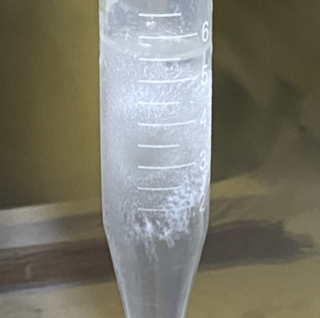
Fluorocarbons are chemical compounds with carbon-fluorine bonds. Compounds that contain many C-F bonds often have distinctive properties, e.g., enhanced stability, volatility, and hydrophobicity. Several fluorocarbons and their derivatives are commercial polymers, refrigerants, drugs, and anesthetics.
Lipophilicity is the ability of a chemical compound to dissolve in fats, oils, lipids, and non-polar solvents such as hexane or toluene. Such compounds are called lipophilic. Such non-polar solvents are themselves lipophilic, and the adage "like dissolves like" generally holds true. Thus lipophilic substances tend to dissolve in other lipophilic substances, whereas hydrophilic ("water-loving") substances tend to dissolve in water and other hydrophilic substances.

Halomethane compounds are derivatives of methane with one or more of the hydrogen atoms replaced with halogen atoms. Halomethanes are both naturally occurring, especially in marine environments, and human-made, most notably as refrigerants, solvents, propellants, and fumigants. Many, including the chlorofluorocarbons, have attracted wide attention because they become active when exposed to ultraviolet light found at high altitudes and destroy the Earth's protective ozone layer.

Liquid breathing is a form of respiration in which a normally air-breathing organism breathes an oxygen-rich liquid which is capable of CO2 gas exchange (such as a perfluorocarbon).

Tetrafluoromethane, also known as carbon tetrafluoride or R-14, is the simplest perfluorocarbon (CF4). As its IUPAC name indicates, tetrafluoromethane is the perfluorinated counterpart to the hydrocarbon methane. It can also be classified as a haloalkane or halomethane. Tetrafluoromethane is a useful refrigerant but also a potent greenhouse gas. It has a very high bond strength due to the nature of the carbon–fluorine bond.

Perfluorohexane, or tetradecafluorohexane, is a fluorocarbon. It is a derivative of hexane in which all the hydrogen atoms are replaced by fluorine atoms. It is used in one formulation of the electronic cooling liquid/insulator Fluorinert for low-temperature applications due to its low boiling point of 56 °C and freezing point of −90 °C. It is odorless and colorless. Unlike typical hydrocarbons, the structure features a helical carbon backbone. In medical imaging it is used as a contrast agent.
Organofluorine chemistry describes the chemistry of organofluorine compounds, organic compounds that contain a carbon–fluorine bond. Organofluorine compounds find diverse applications ranging from oil and water repellents to pharmaceuticals, refrigerants, and reagents in catalysis. In addition to these applications, some organofluorine compounds are pollutants because of their contributions to ozone depletion, global warming, bioaccumulation, and toxicity. The area of organofluorine chemistry often requires special techniques associated with the handling of fluorinating agents.

1-Bromohexane is organobromine compound with formula Br(CH2)5CH3. It is a colorless liquid.

FC-75 is a fluorocarbon derivative of tetrahydrofuran with the chemical formula C8F16O. It is practically insoluble in water.
Perfluorodecalin is a fluorocarbon, a derivative of decalin in which all of the hydrogen atoms are replaced by fluorine atoms. It is chemically and biologically inert and stable up to 400 °C. Several applications make use of its ability to dissolve gases.
The Fowler process is an industry and laboratory route to fluorocarbons, by fluorinating hydrocarbons or their partially fluorinated derivatives in the vapor phase over cobalt(III) fluoride.
Trifluorotoluene is an organic compound with the formula of C6H5CF3. This colorless fluorocarbon is used as a specialty solvent in organic synthesis and an intermediate in the production of pesticides and pharmaceuticals.

Perfluorooctane, also known as octadecafluorooctane, is a fluorocarbon liquid—a perfluorinated derivative of the hydrocarbon octane. It can be a good substitute for insulating oil in high voltage electronics. In addition to heat transfer applications, it has also been used as a breathable fluid in partial liquid ventilation.
Fluorous chemistry involves the use of perfluorinated compounds or perfluorinated substituents to facilitate recovery of a catalyst or reaction product. Perfluorinated groups impart unique physical properties including high solubility in perfluorinated solvents. This property can be useful in organic synthesis and separation methods such as solid phase extraction. In practice, a perfluorinated alkyl group is incorporated into an otherwise conventional organic reagent as an affinity tag. These reagents can then be separated from organic solvents by extraction with fluorinated solvents such as perfluorohexane.

Perfluorotripentylamine is an organic compound with the chemical formula N( 4CF3)3. A molecule of this chemical compound consists of three pentyl groups connected to one nitrogen atom, in which all of the hydrogen atoms are replaced with fluorine atoms. It is a perfluorocarbon. It is used as an electronics coolant, and has a high boiling point. It is colorless, odorless, and insoluble in water. Unlike ordinary amines, perfluoroamines are of low basicity. Perfluorinated amines are components of fluorofluids, used as immersive coolants for supercomputers.

Perfluoro-1,3-dimethylcyclohexane is a fluorocarbon liquid—a perfluorinated derivative of the hydrocarbon 1,3-dimethylcyclohexane. It is chemically and biologically inert.

Perfluoromethylcyclohexane is a fluorocarbon liquid—a perfluorinated derivative of the hydrocarbon methylcyclohexane. It is chemically and biologically inert.
Perfluoromethyldecalin is a fluorocarbon liquid—a perfluorinated derivative of the hydrocarbon methyldecalin. It is chemically and biologically inert. It is mainly of interest as a blood substitute, exploiting the high solubility of air in this solvent.

2,2,5,5-tetramethyltetrahydrofuran (TMTHF) or 2,2,5,5-tetramethyloxolane (TMO) is a heterocyclic compound with the formula C
8H
16O, or (CH3)2(C(CH2)2OC)(CH3)2. It can be seen as derivative of tetrahydrofuran (oxolane) with four methyl groups replacing four hydrogen atoms on each of the carbon atoms in the ring that are adjacent to the oxygen. The absence of hydrogen atoms adjacent to the oxygen means that TMTHF (TMO) does not form peroxides, unlike other common ethers such as tetrahydrofuran, diethyl ether and CPME.

Perfluorocyclohexane or dodecafluorocyclohexane is a chemical which belongs to the class of fluorocarbons, sometimes referred to as perfluorocarbons or PFCs. Fluorocarbons and their derivatives are useful fluoropolymers, refrigerants, solvents, and anesthetics.

















